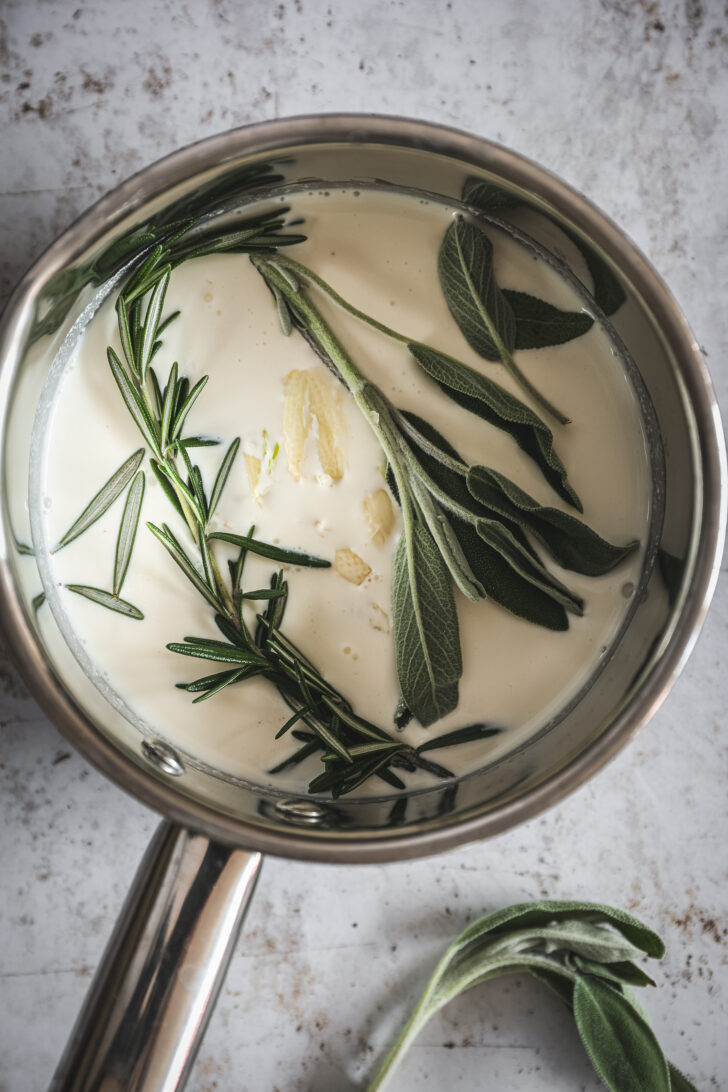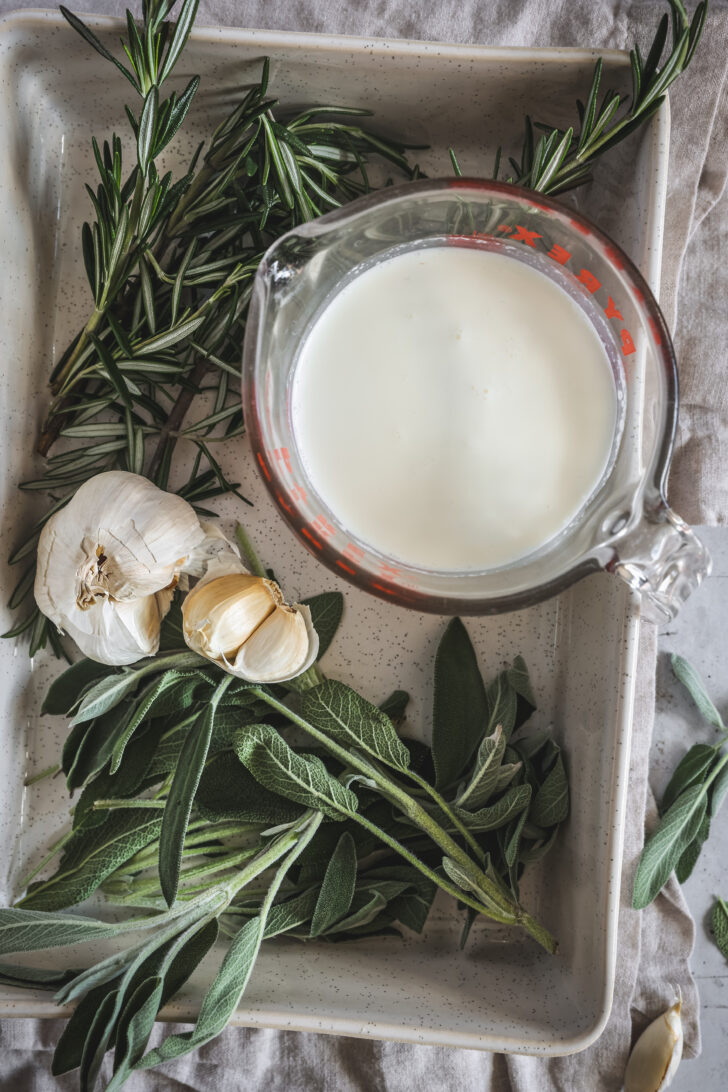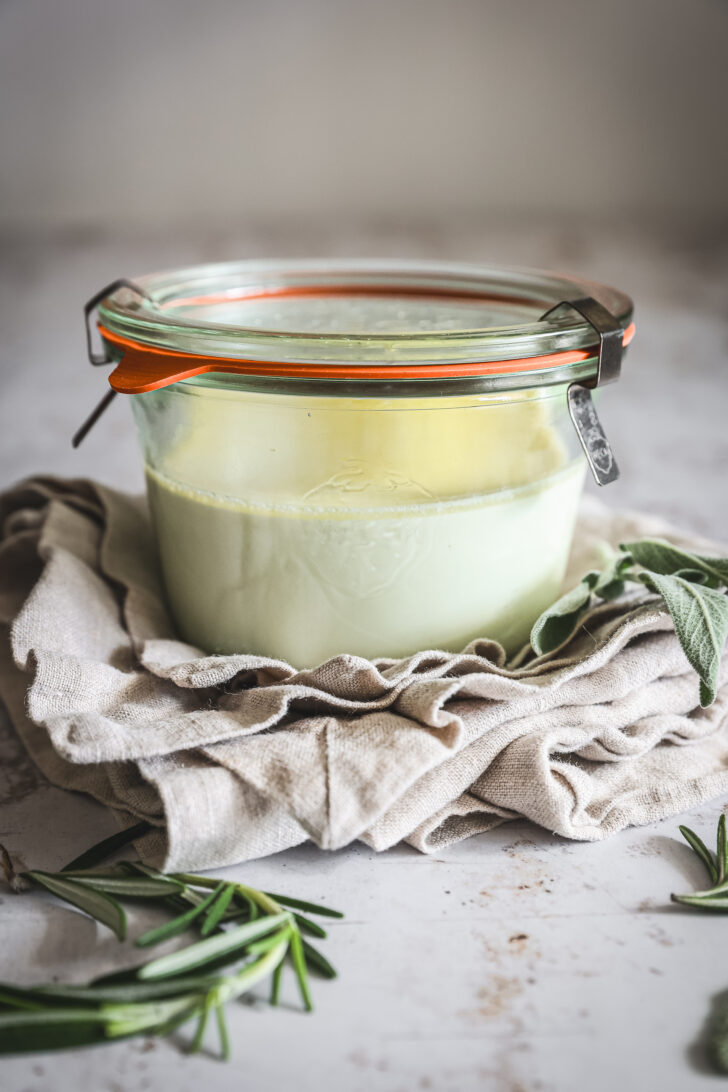Infused Cream
This herb-infused cream weaves subtle, earthy flavors into recipes—just when you think you’ve uncovered it all, there’s more. Stir it into soups or enrich sauces, and even the most simple ingredients will feel transformed. And I promise there are plenty of aromatics below you can mix and match!

Do not forget to check out my Chefs Tips and Wine Pairings sections below!
So, what’s missing from your usual pasta or soup? I’ll tell you—it’s this cream! Garlic, rosemary, sage… sounds basic, but the way these flavors come together is anything but. It might sound like a small change, but once you try this, you’ll start finishing everything with it. A few minutes and you’ll have a secret sauce you won’t stop using.”
Whether you’re tossing it into a sauce, adding it to a soup, or just drizzling it on baked veggies, this cream brings the perfect savory flavor. Quick and easy—and I bet it’s about to become your go-to for, well, just about everything.
And don’t forget, to look below for many more options for what you can put in your cream!
Use your new trick to make some of my cream based recipes even better: Creamy Tuscan Rigatoni, Chicken Tortellini Alfredo, Vodka Sauce
And this one is probably the most impactful to infuse!! Mushroom & Bacon Gratinee
If you want to skip ahead, you can just Jump to Recipe
Why this works
- Simple Technique, Bold Flavor: A simple trick, with way more payoff than you’d thinkᅳwarming heavy cream with garlic, rosemary, and sage doesn’t scream bold flavors, but it quietly builds something so rich and savory, you’ll wonder why you didn’t try it sooner.
- The Ultimate Multi-Tasker: This cream works its way into everythingᅳpasta, soups, you name itᅳwith a deep, savory flavor that sneaks up on you. One minute it’s just cream, the next it’s your kitchen go-to for dishes you didn’t even plan for. And guess what? You hardly have to lift a finger.
- Totally Your Call: Feel free to mix things upᅳswap in different herbs, toss in some spices, or add a kick of heat.You’ve got the basics downᅳnow make it your own! Add in some fresh thyme, swap out the garlic for shallots, or even add a dash of lemon.
- Balance is Key: Low heat, smooth cream, and the right amount of garlic and herbs? You’ve got yourself a velvety texture that’s both delicate and rich. This cream strikes just the right noteᅳrich, but never heavy, with the herbs weaving in quietly to add complexity without stealing the spotlight.
- Make-Ahead Magic: Got a busy week ahead? Prep this over the weekend, and no one will guess how fast you pulled it together. It’s the kind of easy-peasy recipe that’ll have you looking like a kitchen pro when you really just had it stashed in the fridge, ready to go.

Other herb choices
- Garlic: It starts bold and strong, laying down a savory base that anchors everything else. The heat doesn’t hit all at onceᅳit builds, wrapping around the edges, keeping you warm as it slowly fades.
- Rosemary: A punch of Mediterranean air, piney and bright, with a hint of citrus that pulls you into a coastal breeze, balancing the richness.
- Sage: Grounding and slightly mysterious. Its earthy undertones dance with fleeting moments of mint and lemon, bringing depth you didn’t know you needed.
- Thyme: Whispering in the background, thyme works quetlyᅳearthy with a little mintᅳit’s like a shadow to rosemary, making everything just a bit more woodsy.
- Tarragon: A faint, licorice-like note, weaving through the sharper flavors and softening them just enoughᅳwithout losing its quiet sweetness.
- Basil: It’s brightᅳlike a burst of green on your palateᅳwith just enough pepper to leave a lingering warmth, that subtle, sun-soaked aroma trailing behind.
- Oregano: Bold and assertive, with a slightly bitter edge that keeps things from getting too soft. It brings a bit of heat and that unmistakable Mediterranean feel.
- Dill: Like the morning dewᅳfresh, grassy, with a citrusy edge that cuts through the richness, lifting the entire flavor profile.
- Chervil: Delicate and whisper-soft, somewhere between parsley and licorice, adding a refined, almost shy, layer to the mix.
- Parsley: Clean and peppery, it’s the reset buttonᅳbalancing stronger flavors while adding a crisp, refreshing note.
- Mint: Cooling, unexpected, like a quick breath of fresh air in the middle of something deep and savory. It It cuts through the soil-like warmth, leaving behind a sharp brightness that lingers just long enough to make you notice.
- Cilantro: Bright and zesty, almost like squeezing a lemon over everything. It hits with a quick, lively spark, weaving through the richness in unexpected ways, its bright edge lingering just long enough to leave you wondering where the next note will land.
- Marjoram: Sweet, citrusy, but softer than oreganoᅳalmost like it’s whispering rather than shouting. It lays a subtle foundation, letting the Mediterranean herbs steal the show, each one rising to the surface like notes in a well-loved melody.
- Lemon Balm: It adds a light, citrusy note that gently brightens the dish without overpowering other flavors.
- Lavender: Floral and faintly sweet, adding a delicate elegance, but only if you use it sparingly. Too much, and you’ll cross into perfume territory.
Chefs tips
- Taste as You Go: Tasting as you go isn’t just about checking for saltᅳit’s about feeling how every element transforms the dish. At first, it might throw you offᅳa little too sharp, maybe not quite there. But trust the process. Give it time, and the flavors will transform, becoming something more layered and satisfying as they settle.
- Fresh is Best: When fresh basil or rosemary hit the heat, their oils bloom in ways that dried herbs never manage. Sure, dried herbs might work in a pinch, but the complexity you get with fresh herbs? It’s like comparing a whisper to a shout. Their subtle bursts of citrus, pine, and floral notes don’t just sit in the backgroundᅳthey dominate, then fade, only to return with a gentle, unexpected bite.
- Low and Slow for Infusions: Low and slow for infusions: Patience makes all the difference when you’re infusing cream or oils. A gentle, low heat brings out the flavors naturally, keeping everything smooth and rich.
- Strain with Precision: When you’re aiming for that seamless, velvety finish, think of a fine-mesh strainer as your most critical tool. The secret lies in the mesh’s pore sizeᅳtoo large, and you let grit through; too fine, and you risk blocking flow. Use a strainer with around 400 microns for thinner sauces or opt for cheesecloth, with multiple layers, to filter more delicate reductions. Be mindful of the mechanical pressure appliedᅳforcing liquid through can push through starch granules or protein clumps that would otherwise be trapped. And remember, sometimes a slight bit of texture in your sauce adds complexity, but control is keyᅳmaster this step, and you’ll notice how it elevates the mouthfeel from gritty to effortlessly smooth.
- Experiment with flavors: Want to add your own spin? Go for it! The kitchen is all about creativity. Mixing unexpected herbs and spices might just lead to your next favorite recipe. And if it doesn’t work out, that’s part of the processᅳit’s how great flavor combinations are born.
- Season in Layers: Salt is not just a finishing touchᅳit’s a guide throughout the cooking process. By seasoning in stages, you’ll build complexity, allowing the flavors to develop naturally rather than all at once.
- Keep it Precise: Overloading this with too many elements dilutes the impact of your ingredients’ natural aromas and flavors. By limiting your palate, you’re allowing the primary compounds to really stick ouᅳlike isolating one aroma note in a perfume rather than blending too many. A focused plate isn’t just simplerᅳit’s scientifically cleaner, letting each ingredient fully express its texture, acidity, or umami without interference.
- Prep Ahead: Getting everything ready before you start makes cooking much smootherᅳand more fun! This also gives you time to focus on technique instead of scrambling to chop or measure halfway through the process.
Wine Pairings
- For Creamy Pasta or Vegetarian Dishes: When it comes to creamy dishes, a lightly oaked Chardonnay works wonders—there’s a whisper of vanilla that sort of drifts in the background, never overpowering. And Sauvignon Blanc? It slices through that creaminess like a pro, with its acidity doing way more than just “balancing” things out. Feels brighter, fresher. And if you’ve got herbs in there? Well, let’s just say, that fresh, green lift really seals the deal.
- With Rich Meat Dishes: If your cream is part of a sauce for steak or a hearty roast, red wines work best. A Cabernet Sauvignon or a Syrah can stand up to the meat and cream’s richness. Their robust body and tannin structure echo the herbal undertones of rosemary and sage.
- For Seafood Creamy Sauces: When you’ve got seafood and cream together, don’t just settle for any wine—go for one with enough bite to keep things interesting but not so sharp it takes over. A crisp Pinot Grigio or a dry Riesling doesn’t just “cut through” the richness, it slices clean, like a splash of cool sea breeze after a warm day. You’ll feel that zing hit your palate just before the creaminess settles back in. And while the seafood keeps its delicate balance, those wines—well, they don’t just play along, they give it a nudge in the right direction, without ever hogging the spotlight.
- For Poultry Dishes: A medium-bodied white wine like Viognier pairs beautifully, offering floral notes that enhance the cream’s aromatic herbs. If you prefer red, a lighter Pinot Noir provides balance with its bright acidity and fruit-forward character.
- General Tip: Consider the cooking method and the dish’s dominant flavors. Heavily seasoned or robust dishes may need wines with more body or intensity. For lighter dishes, choose wines that offer freshness and acidity.

Faq’s
Yes! See above. For example, thyme, basil, or oregano each add unique flavors. Feel free to experiment.
You can keep it fresh for up to 5 days in an airtight containerᅳjust make sure the seal is tight to lock in all that flavor. Make sure it cools before storing.
For sweets, skip the garlic. Use cinnamon or vanilla instead.
Turn down the heat to avoid curdling. Keep it gentle.
Freezing changes its texture. It’s best fresh or chilled.
Yes, too long makes it too strong. Stick to the recipe time.
They lose flavor after one use. Start fresh for more batches.
Simmer longer to reduce, but watch for curdling.
Infusion affects whipping. Use it where whip isn’t needed.
Stir it into mashed potatoes for an extra layer of richness, swirl it through risottos to make them even creamier, or drizzle it over meats for a subtle, flavorful finish.
Equipment Needed
- Start with a Small Saucepan: Your saucepan is perfect for gently warming the cream, letting the garlic and herbs release their aroma as they infuse together.. It’s all about combining flavors SLOWLY in a simmer.
- Use a Fine-Mesh Strainer: This tool ensures your cream is perfectly smooth, leaving the herbs and garlic out of the final product. It’s your flavor sifter!
- Ready a Bowl: This catches the infused cream once you’ve strained it. Yep, that simple:)
- Spoon or Spatula in Hand: Keep a spoon or spatula handy to stir the cream occasionally, making sure the flavors blend smoothly. It’s your key to even flavor distribution.
- Opt for a Cheesecloth (Optional): For an ultra-smooth texture, line your strainer with cheesecloth. It’s like the final polish for your cream.

Infused Cream
Ingredients
- 1 cup Heavy Cream
- 2-3 cloves of garlic, lightly crushed
- 1 sprig of rosemary
- 1 sprig of sage
Instructions
- Pour the heavy cream into the small saucepan. Add the crushed garlic cloves and the sprigs of rosemary and sage.
- Place the saucepan on the stove over low heat. You want the cream to be warm to the touch but not boiling. The goal is to gently heat the cream to allow the flavors of the garlic and herbs to infuse without curdling the cream.
- Let the cream simmer on the lowest heat setting for about 20-25 minutes. Keep an eye on it to ensure it doesn’t come to a boil. Stir occasionally to ensure that the flavors are evenly distributed.
- After the cream has been infused to your liking (you can taste it to check the strength of the flavor), remove the saucepan from the heat.
- Set the fine-mesh strainer over a bowl and pour the cream through to remove the garlic and herbs. If you want to ensure the cream is completely smooth, you can line the strainer with cheesecloth.
- Allow the infused cream to cool slightly before using it in your recipe. If you’re not using it immediately, store it in the refrigerator.
